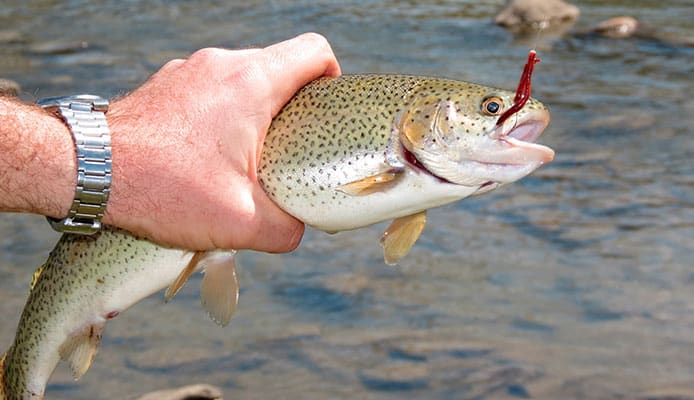
Irrespective of whether you are getting started with fishing for trout or you are an expert, landing a well-played trout is something you would love. If you choose the wrong hook size for trout, however, this can work against you when you are trying to land a picky trout.
Selecting the right trout hook size is as important as selecting the right trout lure. Apart from poor hookups, the wrong hook size for trout could deter your target fish and hence denying you the opportunity to hook the trout at all.
Understanding how the hook sizing works and the ideal hook to use when you are trout fishing is a good way of increasing your odds of reeling in a catch. In this article, we will be explaining everything you need to know about the trout hook size.
Understanding the Trout Hook Size
Before we talk about the ideal hook size for trout, we will discuss how the hook sizing works. Understanding hook sizes, in general, will make things much easier for you when you decide to select a trout hook.
If you are a beginning fisherman, the hook size system may appear deterrent and counter-intuitive. However, understanding the system is pretty easy once it is explained.
The Gauge
The hook sizing system originates from the material the hooks are made from. If you have worn your fishing shirt several times, you probably already know that modern hooks are generally made using metal wires. The metal wires are bent into shape and then sharpened on the ends.
Generally, metals are sized by their gauge. A higher gauge number is used to refer to a thin and light wire. A lower gauge number is used for thick and heavier wires.
The Hook Sizing System
In most instances, the hook sizing system consists of a scale of whole numbers. Similar to a wire, as the number decreases, the size of the hook increases. This tells you that a hook featuring the number 14 is smaller than a hook featuring the number 11.
Large hooks, whose numbers are lower than 1, do exist. Instead of using the negative sign, these hooks are generally listed in their increasing size. That is 1/0, 2/0, 3/0, etc. This tells you that for any hook number that is followed by a zero, the hook size increases as the number increases.
Tip: If you are pronouncing the hook size 2/0, you will need to read it out loud as 2-aught.
The Ideal Hook Size for Trout
The trout hook size is dependent on a variety of factors. These factors include:
- The trout size
- The size and type of bait you intend to use
- The visibility in the water.
As you have probably already guessed, smaller trout fish will require you to use a smaller hook size when compared to the bigger trout. The trout fish has a very good sense of sight. This means that it has the ability to detect hooks easily. For you to succeed at placing the trout in your fishing cooler, your hook should be invisible, to avoid making the trout suspicious.
When choosing the hook size for trout, you need to consider the size of the bait you will be using too. The trout hook size is supposed to be directly proportional to the bait. What this means is that the hook size for trout generally increases as the size of the bait increases.
If you intend to catch trout in lowland lakes featuring murky waters, the ideal hook size should range between 6 and 8. If you have already investigated your fishing spot and determined that once you cast your spinning rod there is a high likelihood of hooking a bigger trout, the hook size ranging between 2 and 4 may work for you.
If you intend to spend your day in crystal clear waters with your portable fish finder, you must invest in smaller hook size. A smaller trout hook size will decrease the chances of the trout fish seeing it. The hook you invest in should feature the number 10 and above.
It is worth noting that you should always focus on using the smallest possible hook size when fishing for trout. On top of having a good sense of sight, the trout fish features exquisite lateral lines capable of detecting abnormal vibrations and pressure in their environment.
It is also worth noting that if you intend to use live bait, the bigger the hook size, the faster it will end up killing the live bait. According to experts, the trout hook sizes should range between 8 and 14.
You might also like: How To Use A Slip Bobber Guide
Is There a Difference Between Trout Hooks and Other Fishing Hooks?
It is not uncommon for someone who has purchased a trout spinning reel for the first time to wonder whether trout fishing hooks look different. The trout fishing hook features the same construction and description as other fishing hooks. The terms used to describe each part of the hook are as indicated below:
- Eye – This is the part used when tying the fishing line to the hook.
- Shank – This is the hook length existing between the hook eye and the bend start.
- Bend – This the curve forcing the point to face forward.
- Point – This is the sharpened end. It allows the hook to set in the trout’s mouth.
- Gape – This is the distance existing between the shank and the point.
- Throat/Bite – The distance between the start of the bend and the point.
- Barb – This is the sharp spike usually bent from the back of the hook point. Its purpose is to ensure that the hook does not fall out of the fish’s mouth.
The Ideal Hook Styles for Trout Fishing
Although a wide range of hook styles and shapes do exist, trout fishing keeps things simple. If you intend to go after the trout fish after wearing your fishing hat, you will probably use a treble hook, barbless hook, or a straight shank single hook. In this section, we will be explaining these types of hooks.
Single Hooks
A barbed straight shank hook featuring the appropriate trout hook size is an ideal choice for the majority of trout fishing. A single hook allows you to fish a wide range of baits, including power bait and worms.
On top of being cost-effective, the single hooks are generally an easy choice. Even when barbed, the single hooks present a great opportunity for releasing the trout unharmed compared to when you are using other types of fishing hooks.
Treble Hook
If you intend to keep the trout you land, using the treble hook may be a good idea. This type of hook does not let go once it hooks into the trout fish.
The treble hook generally features 3 hooks welded together. These are molded into a single eye where you attach your braided fishing line.
The downside to using this hook is that it can be extremely damaging to the fish. This tells you that it is not an ideal option if you wish to release the trout fish you land during your fishing trip.
Barbless Hooks
When compared to the single barbed hooks, these are more ideal for trout fishing when you intend to release the fish you catch. These are the recommended hook type when you are fishing in regions where regulations require you to release the fish you land.
Generally, the majority of fishing hooks will feature a reversed barb near the end of the sharp tip. While the reversed barb is usually small, it does a great job when it comes to holding onto the fish. Even if you happen to lose the slack in the fishing line briefly, the barb should remain in the fish’s mouth. Barbless hooks do not have this feature.
The barbless hooks are smooth. This means that removing the hook from the trout mouth is generally easier. The fact that removing the hook is much easier means that losing your trout mid-battle is always a possibility.
If you are fishing for trout using a barbless hook, you must maintain the fishing line tension throughout the battle. If you lose the tension, even for a couple of seconds, the hook will most likely slip from the trout’s mouth.
If you currently own a couple of barbed hooks, you do not have to invest in a barbless hook if you do own a pair of pliers. All you will need to do is use your pair of pliers to compress the barb. This should remove its functionally.
Tip: Use Sharp Hooks
Apart from using the wrong hook size for trout, an additional reason why the majority of trout anglers end up losing their fish is using blunt hooks. To increase your chances of landing a trout, you should always carry a sharp hook. This, however, does not mean that you need to purchase a new hook every time you plan to go trout fishing. Having a hook sharpener is much cheaper when compared to changing the hook regularly.
Globo Surf Overview
When selecting the hook size for trout, you need to keep in mind that the trout fish can detect something out of the normal in its surrounding. You should, therefore, make sure that the trout hook size you use is not too visible. In murky waters, a bigger hook size may be ideal. However, in clear waters, the big-sized hooks will be too visible.
It is worth noting that compared to fish like bass, the trout fish features a much smaller mouth. Therefore, the average hook size for trout should be on the smaller side.


